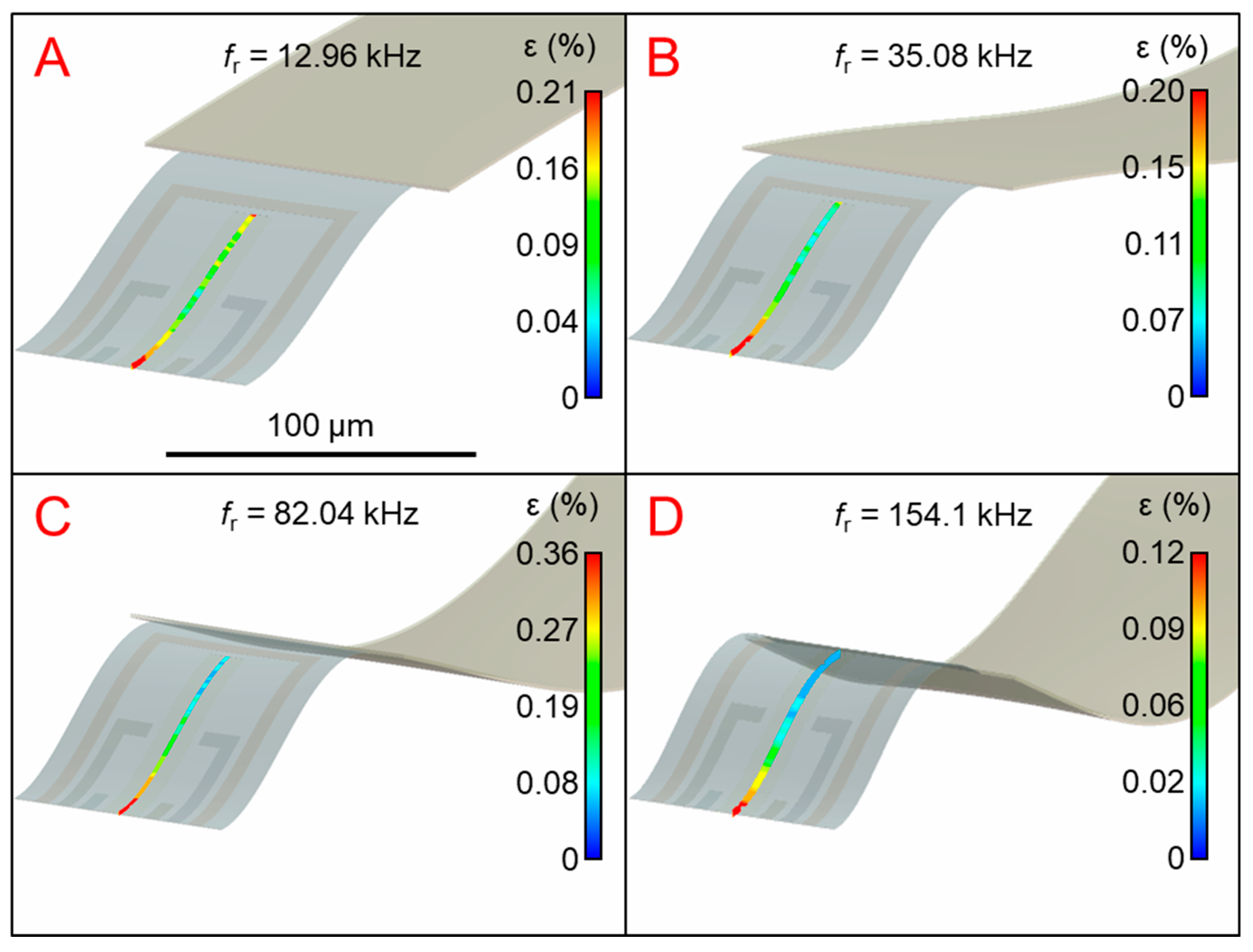A New Method for 2D Materials Properties Modulation by Controlled Induced Mechanical Strain †
Abstract
:1. Introduction
2. Numerical Model of Piezoelectric Resonator

3. Results and Discussion
4. Conclusions
Acknowledgments
Conflicts of Interest
References
- Gablech, I.; Pekárek, J.; Klempa, J.; Svatoš, V.; Sajedi-Moghaddam, A.; Neužil, P.; Pumera, M. Monoelemental 2D materials-based field effect transistors for sensing and biosensing: Phosphorene, antimonene, arsenene, silicene, and germanene go beyond graphene. TrAC Trends Anal. Chem. 2018, 105, 251–262. [Google Scholar] [CrossRef]
- Dong, J.; Liu, S.; Fu, Y.; Wang, Q. Investigation of strain-induced modulation on electronic properties of graphene field effect transistor. Phys. Lett. A 2017, 381, 292–297. [Google Scholar] [CrossRef]
- Putnik, M.; Cardanobile, S.; Nagel, C.; Degenfeld-Schonburg, P.; Mehner, J. Simulation and modelling of the drive mode nonlinearity in MEMS-gyroscopes. Procedia Eng. 2016, 168, 950–953. [Google Scholar] [CrossRef]
- Choi, S.-M.; Jhi, S.-H.; Son, Y.-W. Controlling Energy Gap of Bilayer Graphene by Strain. Nano Lett. 2010, 10, 3486–3489. [Google Scholar] [CrossRef] [PubMed]




Publisher’s Note: MDPI stays neutral with regard to jurisdictional claims in published maps and institutional affiliations. |
© 2018 by the authors. Licensee MDPI, Basel, Switzerland. This article is an open access article distributed under the terms and conditions of the Creative Commons Attribution (CC BY) license (http://creativecommons.org/licenses/by/4.0/).
Share and Cite
Gablech, I.; Pekárek, J.; Klempa, J.; Vyroubal, P.; Svatoš, V.; Neužil, A.P. A New Method for 2D Materials Properties Modulation by Controlled Induced Mechanical Strain. Proceedings 2018, 2, 1513. https://doi.org/10.3390/proceedings2131513
Gablech I, Pekárek J, Klempa J, Vyroubal P, Svatoš V, Neužil AP. A New Method for 2D Materials Properties Modulation by Controlled Induced Mechanical Strain. Proceedings. 2018; 2(13):1513. https://doi.org/10.3390/proceedings2131513
Chicago/Turabian StyleGablech, Imrich, Jan Pekárek, Jaroslav Klempa, Petr Vyroubal, Vojtěch Svatoš, and And Pavel Neužil. 2018. "A New Method for 2D Materials Properties Modulation by Controlled Induced Mechanical Strain" Proceedings 2, no. 13: 1513. https://doi.org/10.3390/proceedings2131513
APA StyleGablech, I., Pekárek, J., Klempa, J., Vyroubal, P., Svatoš, V., & Neužil, A. P. (2018). A New Method for 2D Materials Properties Modulation by Controlled Induced Mechanical Strain. Proceedings, 2(13), 1513. https://doi.org/10.3390/proceedings2131513




